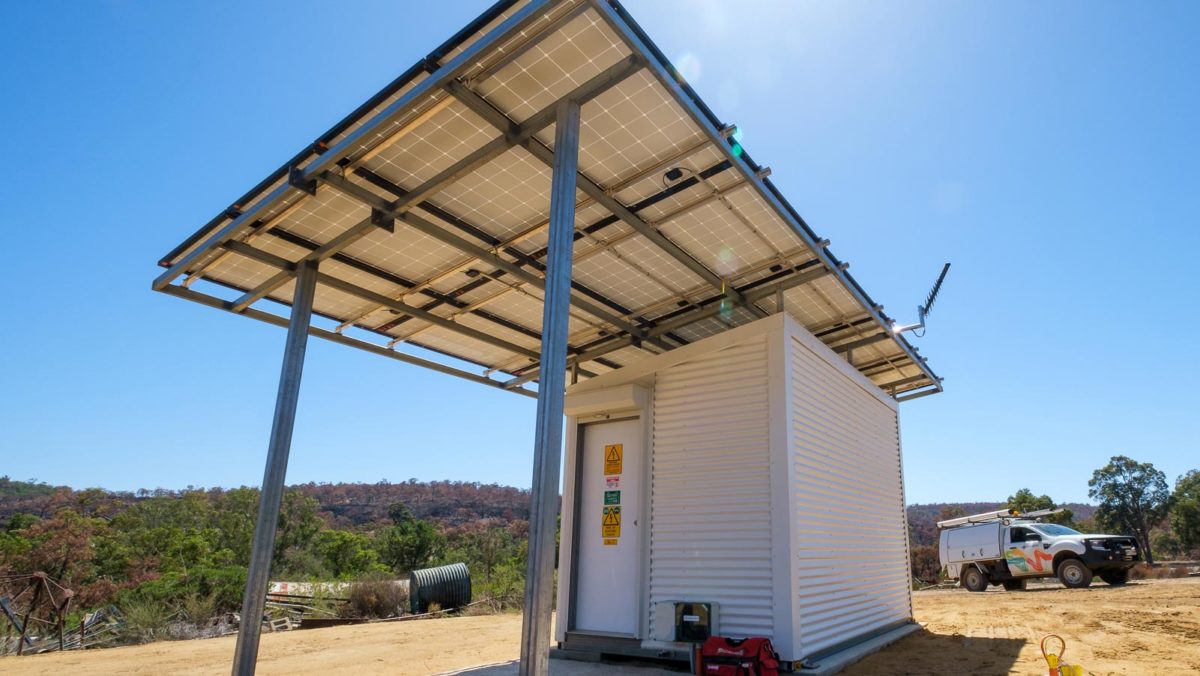Previously only used in regional and remote locations, Western Australia has now brought stand-alone systems, which include a solar array, battery and back-up generator, into the metropolis. The deployment is part of a major electricity network rebuild in areas affected by the Wooroloo bushfire, with crews working overtime to restore power to 220 properties.
Metropolitan as they may be, the two Perth Hills properties where the SAPS units, also known as SPS units, have been deployed are located on challenging terrain. Mutually beneficial, deploying the off-grid system removes the need for Western Power to repair over 2 kilometres of poles and wires connecting the properties, while improving power reliability and quality for the landowners.
“The bushfire was devastating for people in these areas and decimated much of the network assets out there with around 579 poles, 47 transformers and 56 underground assets damaged or destroyed,” Western Power CEO Ed Kalajzic said in a statement.
“We had a good look at where we could use technology and alternative solutions to replace these assets to improve both power supply and operational efficiencies for the benefit of the community.”
Stand-alone power systems have become somewhat of a darling in the state. Just last week, the state government announced it will rollout another 1000 SAPS if re-elected in March. The systems are a natural fit for the state, which is vast but sparsely populated. The units reduce the need for traditional poles and wires to cover expanses, and simultaneously offer customers more reliable and greener power.
“During the last five years we’ve made significant progress to transform the grid using innovative technology and incorporating renewable energy, so we wanted to use this where we can for those affected,” Kalajzic said.
Over the last few years, the state has facilitated the roll out of hundreds of stand-alone systems in rural properties. The state-owned energy supplier Horizon Power, alongside Western Power, have already transitioned properties throughout the Mid West, Goldfields, eastern Wheatbelt and Great Southern regions. It calculates that even with servicing the systems throughout their expected life cycle, the utility will save $6 million dollars on not having to refurbish the network to ensure reliability of supply to those properties.
Now WA is embracing the solution not only overcome distance, but also fire damage – something the Climate Council pushed for following the Black Summer fires in 2020.
Today, over 200 Western Australian households still remain without power due to damage caused by the Wooroloo Perth Hills bushfire, which burned for a week and destroyed over 85 houses between February 1st and 8th. In response, Western Power have set up a temporary depot in the area, supported by local businesses.
“This has been one of the largest rebuilds we’ve ever undertaken and we‘ve had around 270 employees and 200 light, heavy and support vehicles on the ground every day for the past two weeks,” Kalajzic said.
“We expect to complete the restoration by the end of February and will continue to work as quickly and safely as possible.”
“It’s been a fantastic collaborative effort and we’re proud to work alongside the Department of Fire and Emergency Services and other emergency and support services, to support the community during the bushfire and moving forward.”
This content is protected by copyright and may not be reused. If you want to cooperate with us and would like to reuse some of our content, please contact: editors@pv-magazine.com.









While applauding this initiative, a little perspective may be interesting.
The Solar Energy Research Institute of WA (SERIWA) was established by statute in 1977, with a (then) fairly generous competitive R&D grants scheme as well as a significant in-house R&D scheme which included the RAPS – Remote Area Power Supply program.
RAPS was designed to provide amenity to remote indigenous groups, using sea containers with PVs on top and specially designed fridges and lighting inside. The logic was that not only was this cost effective against unreliable diesel, but enable a learning curve while prices reduced with increasing use of PVs. There was also local employment with the prospect of exports.
SERIWA was shut down in 1986 in a time of budget stringency. Several of us were able to convince the Burke Government to keep RAPS, which was given to Murdoch University with some early finance for the Murdoch University Energy Research Institute.
With inadequate funding, the RAPS program faded by the early ‘nineties.
At that same timer (1986) I commissioned Dr Mark Diesendorf to investigate the prospects for a wind-power industry in WA. Again, at that time, WA had the beginnings of a promising industry, but great reluctance by the SEC to do more than a token effort. The very positive report sunk into the sand.
One might wonder how big an export business we would have in WA now- with 40 years of solid experience- if governments weren’t so capricious.
Just saying!